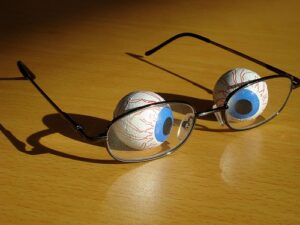Convergence insufficiency… does it sound like the reason you can’t button your skinny jeans? It’s actually an unrecognized vision problem that can wreak havoc with your child’s reading.
Convergence insufficiency is remarkably common issue, experienced by an estimated twenty million Americans, as explained on this helpful infographic posted by Dr. Dominick Mainos, OD, Med, FAAO, F-COVD-A on his great blog, MainosMemos. (I encourage everyone with an interest in vision in children, developmental disabilities, or brain trauma to invest some time there.)
Look inward
To get the idea of convergence, hold up an index finger about 8 inches or so in front of your nose. Focus both eyes on it as you move it slowly toward your face. Your eyes will turn inward together to follow your finger, and this movement is convergence. If you have a deficiency, your eyes will not move inward normally and the image you see may blur or overlap more than normal, as the muscles that move the eyes are not quite up to the task.
What to look for in kids
Convergence deficiency creates problems in tasks like reading and writing. But like so many vision problems I treat, it’s often overlooked and undetected by routine vision screening exams. Typical symptoms include a bright child who nevertheless has difficulties in school, especially with close work. He or she may have headaches, eyestrain, drowsiness, and double or blurred vision. Problems like this often underlie low confidence and behavioral issues. Dr. Mainos points out that many of these children are misdiagnosed with Attention Deficit Hyperactivity Disorder (ADHD). Another common label is learning disabled.
What to do
If you’re a parent noticing symptoms like these, I encourage you to have your child examined by a developmental optometrist; for help finding one, check the COVD website www.covd.org. Convergence deficiency can often be treated by office-based vision therapy with good success. Treatment can involve exercises like pencil pushups—practicing focusing on a pencil as the child moves it closer—or computer-based therapy. Improvement may be seen in a few weeks, and complete treatment, a few months.
Photo by net_efekt, Flickr
- It’s Never too Late to Expand Your Vision - February 1, 2023
- It’s Never Too Late To Expand Your Vision Interview - January 27, 2023
- Dr. Hellerstein’s Featured COVD Interview - September 25, 2022



Comments are closed.